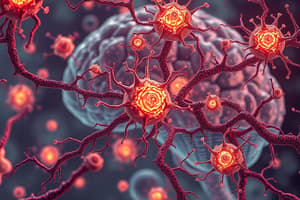Podcast
Questions and Answers
What type of stimulus is required for an action potential to be generated?
What type of stimulus is required for an action potential to be generated?
- Multiple stimuli
- Hyperpolarization
- A threshold level depolarization (correct)
- A suprathreshold stimulus
In which area of the neuron is an action potential initially generated?
In which area of the neuron is an action potential initially generated?
- B
- C (correct)
- D
- A
Which of the cell types shown is most associated with the production and flow of cerebrospinal fluid (CSF)?
Which of the cell types shown is most associated with the production and flow of cerebrospinal fluid (CSF)?
- B
- C
- A
- D (correct)
What structural classification describes this neuron?
What structural classification describes this neuron?
Which areas of this neuron would be classified as receptive regions?
Which areas of this neuron would be classified as receptive regions?
Which of the neuroglial cell types shown form myelin sheaths within the CNS?
Which of the neuroglial cell types shown form myelin sheaths within the CNS?
Which of the following membrane regions would have significant numbers of voltage-gated ion channels?
Which of the following membrane regions would have significant numbers of voltage-gated ion channels?
Outside of the neuron is ____________ at resting membrane potential.
Outside of the neuron is ____________ at resting membrane potential.
Inside of the neuron is ___________ at resting membrane potential.
Inside of the neuron is ___________ at resting membrane potential.
The resting membrane potential of a neuron averages _______mV.
The resting membrane potential of a neuron averages _______mV.
The membrane is more permeable to _______.
The membrane is more permeable to _______.
The concentration of _______ is higher inside than outside the cell.
The concentration of _______ is higher inside than outside the cell.
The concentration of ________ is higher outside than inside the cell.
The concentration of ________ is higher outside than inside the cell.
The resting membrane potential is maintained by Na+-K+ pumps that actively transport _____ into and ____ out of the cell.
The resting membrane potential is maintained by Na+-K+ pumps that actively transport _____ into and ____ out of the cell.
During the action potential, what channels open and close to alter the permeability of the plasma membrane to Na+ and K+ ions?
During the action potential, what channels open and close to alter the permeability of the plasma membrane to Na+ and K+ ions?
Place the events involved in generation of an action potential in the correct order of occurrence from left to right.
Place the events involved in generation of an action potential in the correct order of occurrence from left to right.
Study Notes
Neuroglial Cells and Action Potentials
- Neuroglial cells in the peripheral nervous system include Schwann cells and satellite cells.
- Action potentials are generated by a threshold level depolarization, requiring a specific change in membrane potential.
- The initial site of action potential generation in a neuron is typically at the axon hillock.
Cerebrospinal Fluid and Neuron Structure
- Ependymal cells are primarily associated with the production and circulation of cerebrospinal fluid (CSF).
- Neurons can be structurally classified as multipolar, characterized by having multiple extensions from the cell body.
- Receptive regions of a neuron are typically dendrites and the cell body.
Membrane Potential and Ion Concentrations
- Myelin sheaths in the central nervous system are formed by oligodendrocytes.
- Significant voltage-gated ion channels are located in areas known as the axon hillock and nodes of Ranvier.
- At resting membrane potential, the outside of the neuron is positively charged, while the inside is negatively charged.
Resting Membrane Potential Details
- The average resting membrane potential of a neuron is approximately -70 mV.
- The neuron’s membrane is more permeable to potassium ions (K+) than to sodium ions (Na+).
- K+ concentration is higher inside the cell, whereas Na+ concentration is higher outside.
Ion Transport and Action Potential Mechanism
- The resting membrane potential is maintained by Na+-K+ pumps, which actively transport Na+ out and K+ into the cell.
- Voltage-gated channels are crucial for the action potential as they open and close to regulate permeability to Na+ and K+ ions during the depolarization and repolarization phases.
Sequence of Action Potential Events
- Action potential generation follows a succession of events:
- Threshold stimulus triggers the opening of Na+ channels.
- Na+ influx causes depolarization.
- Na+ channels close, while K+ channels open, resulting in K+ efflux and repolarization.
- Hyperpolarization occurs as K+ channels eventually close.
Studying That Suits You
Use AI to generate personalized quizzes and flashcards to suit your learning preferences.
Description
Test your knowledge on the fundamentals of the nervous system with these flashcards. This set covers neuroglial cell types, action potentials, and essential concepts from Chapter 11. Perfect for students looking to reinforce their understanding of the PNS and related physiological processes.




